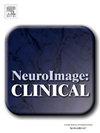对可能患有淀粉样小血管疾病和非淀粉样小血管疾病的患者的 CSVD 成像标记进行定量比较。
IF 3.4
2区 医学
Q2 NEUROIMAGING
引用次数: 0
摘要
脑微出血的空间分布模式与不同类型的脑小血管疾病(CSVD)有关。本研究旨在探讨被诊断为可能患有淀粉样变性小血管疾病和非淀粉样变性小血管疾病的患者在脑部成像标志物方面的差异。本研究收集了本研究所 351 名患者的头部磁共振扫描图像,包括感度加权成像(SWI)序列,并对其进行了分析。对患者图像中不同尺寸的 CSVD 成像标记进行了量化或分级。根据微出血的空间分布,将患者分为脑淀粉样血管病变组(CAA)、高血压动脉病变组(HA)和混合小血管病变组(Mixed)。使用人工神经网络分割白质病变(WML),并通过体素方法进行评估。三组患者在以下几项指标上存在显著差异:微小出血点计数、半卵圆中心和基底节水平的裂隙计数、基底节血管周围空间扩大等级(EPVS)和白质病变体积。与其他组相比,混合组的这些指数都要高得多。此外,HA 组脑出血(χ2 = 7.659,P = 0.006)和近期皮层下小梗死(χ2 = 4.660,P = 0.031)的发生率明显高于 CAA 组。这些结果表明,微出血的混合空间分布模式显示出脑小血管疾病的最高负担。与皮层区的微出血相比,位于脑深部的微出血与近期皮层下小梗死和脑出血的发生率较高有关。本文章由计算机程序翻译,如有差异,请以英文原文为准。
Quantitative comparison of CSVD imaging markers between patients with possible amyloid small vessel disease and with non-amyloid small vessel disease
The spatial distribution patterns of cerebral microbleeds are associated with different types of cerebral small vessel disease (CSVD). This study aims to examine the disparities in brain imaging markers of CSVD among patients diagnosed with possible amyloid and non-amyloid small vessel disease. The head MR scans including susceptibility-weighted imaging (SWI) sequences from 351 patients at our institute were collected for analysis. CSVD imaging markers were quantified or graded across various CSVD dimensions in the patient images. Patients were categorized into the cerebral amyloid angiopathy group (CAA), hypertensive arteriopathy group (HA), or mixed small vessel disease group (Mixed), based on the spatial distribution of microbleeds. White matter lesions (WML) were segmented using an artificial neural network and assessed via a voxel-wise approach. Significant differences were observed among the three groups in several indices: microbleed count, lacune count at the centrum semiovale and basal ganglia levels, grade of enlarged perivascular space (EPVS) at the basal ganglia, and white matter lesion volume. These indices were substantially higher in the Mixed group compared to the other groups. Additionally, the incidences of cerebral hemorrhages (χ2 = 7.659, P = 0.006) and recent small subcortical infarcts (χ2 = 4.660, P = 0.031) were significantly more frequent in the HA group than in the CAA group. These results indicate that mixed spatial distribution patterns of microbleeds demonstrated the highest burden of cerebral small vessel disease. Microbleeds located in the deep brain regions were associated with a higher incidence of recent small subcortical infarcts and cerebral hemorrhages compared to those in the cortical areas.
求助全文
通过发布文献求助,成功后即可免费获取论文全文。
去求助
来源期刊

Neuroimage-Clinical
NEUROIMAGING-
CiteScore
7.50
自引率
4.80%
发文量
368
审稿时长
52 days
期刊介绍:
NeuroImage: Clinical, a journal of diseases, disorders and syndromes involving the Nervous System, provides a vehicle for communicating important advances in the study of abnormal structure-function relationships of the human nervous system based on imaging.
The focus of NeuroImage: Clinical is on defining changes to the brain associated with primary neurologic and psychiatric diseases and disorders of the nervous system as well as behavioral syndromes and developmental conditions. The main criterion for judging papers is the extent of scientific advancement in the understanding of the pathophysiologic mechanisms of diseases and disorders, in identification of functional models that link clinical signs and symptoms with brain function and in the creation of image based tools applicable to a broad range of clinical needs including diagnosis, monitoring and tracking of illness, predicting therapeutic response and development of new treatments. Papers dealing with structure and function in animal models will also be considered if they reveal mechanisms that can be readily translated to human conditions.
 求助内容:
求助内容: 应助结果提醒方式:
应助结果提醒方式:


